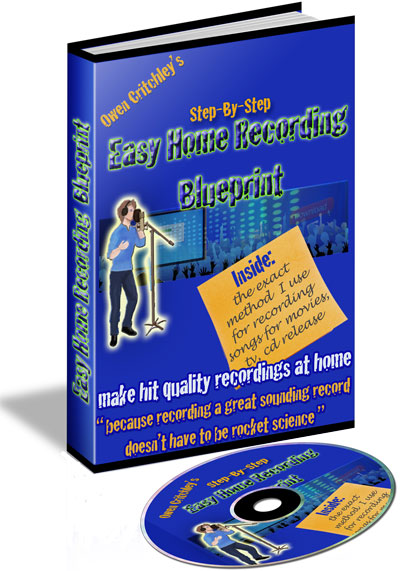Easy Home Recording Blueprint
Learn to Produce Music – Approaching Music Production Like the Greats – Home Recording Blueprint
What is a music producer really? Judging from the typical discussion out there, you would think that he or she is primarily a technical professional. Like a NASA flight engineer or an electrical contractor.
The truth is that great producers don’t dream at night of circuit boards and the latest studio equipment. Great music producers spend their time building and nurturing an intimate relationship with sound and the almost mystical way that different combinations of sound stimulate and play on our emotions in ways that words alone cannot.
That said, the sounds we use as accompaniment for a song, should be chosen to serve the words and meaning of a song. The sounds, instrumentation, tempo, rhythm etc serve as inflection and expression.
Think of it this way: Imagine that someone is telling you something very meaningful. First picture them telling you this important thing in the voice of The Terminator or an automated telephone operator. Then picture them telling you this important thing with a tremble in their voice and a tear on their cheek. You see, it’s the inflection and accompaniment that make the words either profound or empty.
So, to learn to produce music like the great producers, you first have to learn to truly understand the mood, meaning and emotion of a song or piece of music. In other words, make sure you understand what you are going to say before you say it.
When you do understand the meaning and intent of a song that you are going to produce, the actual production of the piece becomes a much simpler, more enjoyable and much more rewarding task. Why?
If you take the time to understand the intent and meaning of a song or piece of music, the choices of instrumentation become obvious. Instead of facing infinite choices of sounds to support the song’s emotional flow and meaning, you instead are able to narrow down the choices to a few logical possibilities.
Learn to Produce Music – A Producer’s Practical Examples
Let’s imagine a hypothetical song. Let’s say this song has a quiet section and the lyric is telling you that a character in the song is about to make a huge and perhaps dramatic decision. Let’s say the main instrumentation is a piano or acoustic guitar during this section.
Instead of facing a thousand instrumentation choices in this scenario, because you understand the drama and importance of the lyric, you might settle on a single low bell sound to support the piano or guitar, as if it is being struck with a felt covered mallet.
Suddenly the drama and profound emotion of this section’s lyric is made apparent to the listener and the all important “emotional response” from him or her is achieved.
Let’s look at an entirely different kind of song. Imagine an upbeat house music style and imagine the lyric is simply about the joy of getting off work to go party the night away. Instead of a wall of sound from start to finish, you want an effective and memorable set of sounds that appear for crucial moments in the groove, to set the song apart from the pack.
So, in this case instead of typical back up vocals for the big chorus, you might decide to have the sound of a chanting soccer crowd to accompany the lead vocal. This drives home the joy and excitement of the moment and sweeps the listener up in the chaos and electricity as the song describes the night that is unfolding.
Imagination first, recording second
You see, as you learn to produce music, it’s important to always keep your creative imagination as your first priority. Anyone can learn to record music effectively and use the tools of the trade, but those who go on to be great producers are the ones who use sound to tell a story.
Learn the language and emotional power of sound and the whole world will listen.
I will continue this series of articles about becoming a music producer. Next time we will look at the actual recording process. We will look at surprisingly simple ways to record audio clearly and beautifully. We’ll find out how to record easily using very little recording equipment, while still capturing the meaning and mood of our songs.
I invite you to find out more as you learn to produce music. I invite you to take advantage of my free home recording blueprint lessons and find out the astonishingly simple Home Recording Blueprint method I use to record songs and music for movies, TV, CD release, licensing etc.
Warner/Chappell, Hi Bias, Audio Socket and LoudThud recording artist, songwriter and producer, Owen Critchley has been writing, recording and releasing music for over 15 years. For more information about Owen and his home recording tips, and how to be successful in the new music business,
Article Source: EzineArticles
Author: Owen Critchley


This artical was awesome, I’am Looking forward to your next artical in Producing Music. I’am a Mix Engineer and Learning to Produce will help me in so many ways, as well as my Writing.
thanks again Bill McDonald
I have been exploring for a little for any high quality articles or blog posts in this kind of space . Exploring in Yahoo I eventually stumbled upon this web site. Studying this information So i’m happy to exhibit that I’ve a very excellent uncanny feeling I came upon just what I needed. I such a lot for sure will make certain to don?t fail to remember this site and give it a glance on a relentless basis.